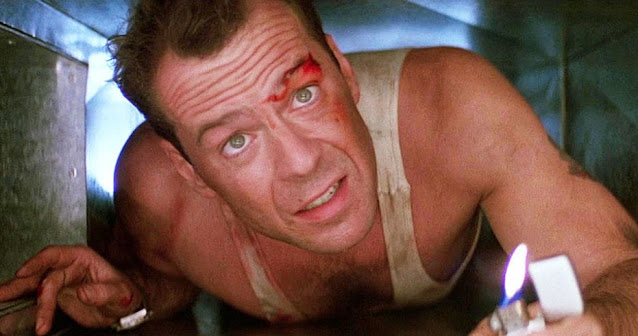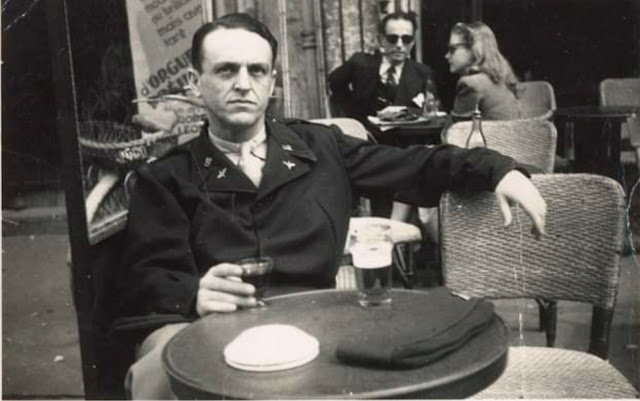Zero-Gravity Training for "Apollo 13"
In order to shoot a realistic film about space travel, director Ron Howard first had to figure out how he was going to depict weightlessness. During a visit to NASA, he learned that real astronauts trained for a weightless environment in NASA's KC-135 weightless trainer – the “Vomit Comet” – a hollowed-out, windowless, padded Boeing 707 jet that climbs to 30,000 ft. and then arcs into a steep dive, creating a 23-second period of weightlessness. When the jet reaches the bottom of its dive and arcs back up, the zero-gravity environment instantly disappears, becoming a crushing two gravities. As it begins to climb, the passengers and crew hit the deck.
 |
| The Apollo 13 filmmakers first had to solve the problem of how to realistically depict zero-gravity |
Kevin Bacon recalled, “Ron called me up and said, ‘We’re going up in this zero-g airplane. And it’s for research. You don’t have to go. Absolutely no pressure. If you don’t want to go, you don’t have to go. Tom’s going to go. Gary’s going to go. Bill’s going to go. I’m going to go.’ You know, everybody was going to go. So, of course, I’m not going to look I’m an idiot. I mean, there is a certain element of my personality that is slightly male.”
To experience the “Vomit Comet,” Tom Hanks, Bill Paxton, Kevin Bacon and Gary Sinise joined director Ron Howard and producer Todd Hallowell at Ellington Air Force Base. For their first zero-gravity flight, the KC-135 flew out to a distant spot in the Gulf of Mexico – remote waters hundreds of miles from a populated area. That morning, NASA medics prescribed to each of the “actor-nauts” a potent drug cocktail of scopolamine and Dexedrine to relieve motion sickness. In the breast pockets of each man’s suit was what NASA technicians call the “airman’s corsage” – two plastic bags with sealable tops, just in case.
For the first few dips, the passengers stayed strapped in their seats. On the fourth one, Paxton unbuckled his restraints and the others hesitantly followed suit, floating weightless for the first time. “Bill loved it,” said Ron Howard. “He took to it like a duck to water. He just absolutely loved being weightless. We all did.”
 |
| Tom Hanks and Kevin Bacon experiencing weightlessness for the first time |
"I was the wimp," admitted Kevin Bacon. "I thought we'd go up in the plane once. We went on 40 zero-g trips." Before the flight ended, Bacon and Sinise both lost their lunch.
Afterward, Howard bragged, “Test directors came up and said, ‘You know, we expected you to be a bunch of Hollywood wimps.’” Hanks said, “We assured the guys down there that we were kind of up to it, and then we were saying, ‘Boy, is it possible to put a set in here and shoot part of a movie?’”
Kevin Bacon wasn’t so keen on the idea, but tried to seem game. “Ron comes to me and says, ‘Well, our stunt coordinator Mickey Gilbert had an idea. He wants to go up there and film it. I don’t know if we can do it. We’ll check with NASA.’ I was like, ‘Oh.’”
Producer Todd Hallowell started working the phones, hoping to get permission to place the Command Module and Lunar Module sets inside the KC-135 for filming weightless effects. “We kept pushing on this and finally got it all the way to Washington, to NASA Administrator Dan Goldin’s office,” said Hallowell. “And they finally came back and said, ‘Well, let’s do that.’”
 |
| The Apollo 13 crew filming on the "Vomit Comet" |
That was a big relief for Ron Howard. “If we’d had to do it with wires – if we really would’ve had to try to create the weightlessness with wires, I shudder to think what the movie would have looked like,” he said. “Ultimately, every director has to bear the final responsibility for what goes on in shooting a movie. If I had really understood before going into it what was involved in shooting in the KC-135, I might have backed away from it. There were the financial issues to consider, there were logistical issues, like how we were going to make the set fit inside the confines of the plane, there was the simple question of whether it really was possible to stage the scenes we wanted to stage in a zero-g environment. At a certain point, I just said, ‘If the actors are willing to give it a try, I’m willing to. If it works, it’s unprecedented, if it doesn’t, it doesn’t.’ I certainly wasn’t on an irrational mission, but I also knew that no matter how wonderful the special-effects wizards working on the movie were, there was no way simulated weightlessness would look as good as the real thing.”
Cindy Pearlman, “The Making of Apollo 13: A Countdown,” Chicago Sun-Times, 6/25/95
Cindy Pearlman, “Space Race,” Chicago Sun-Times, 6/25/95
Jeffrey Kluger, The Apollo Adventure, Pocket Books, 1995
Richard Corliss, “Hell of a Ride,” Time, 7/3/95
Malcolm Jones, Jr., “Out of this World, Really,” Newsweek, 7/3/95
Lynda Jones, “Apollo 13 Takes a Dive,” Science World, 10/6/95
Apollo 13 DVD Extras: Lost Moon Featurette
Apollo 13 DVD Extras: Director Commentary


Comments